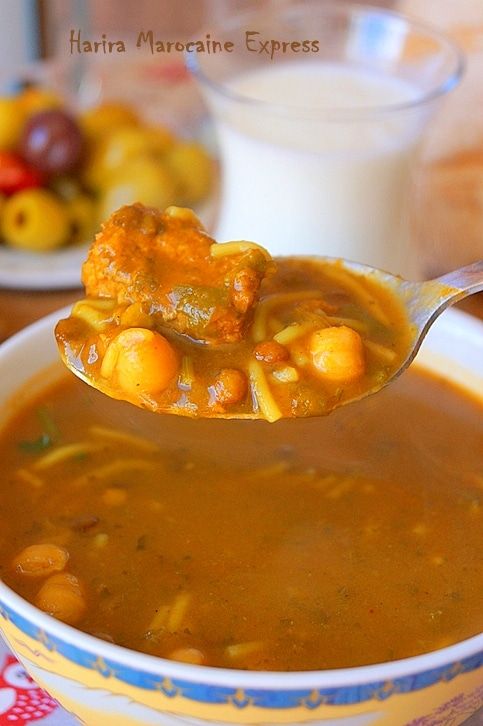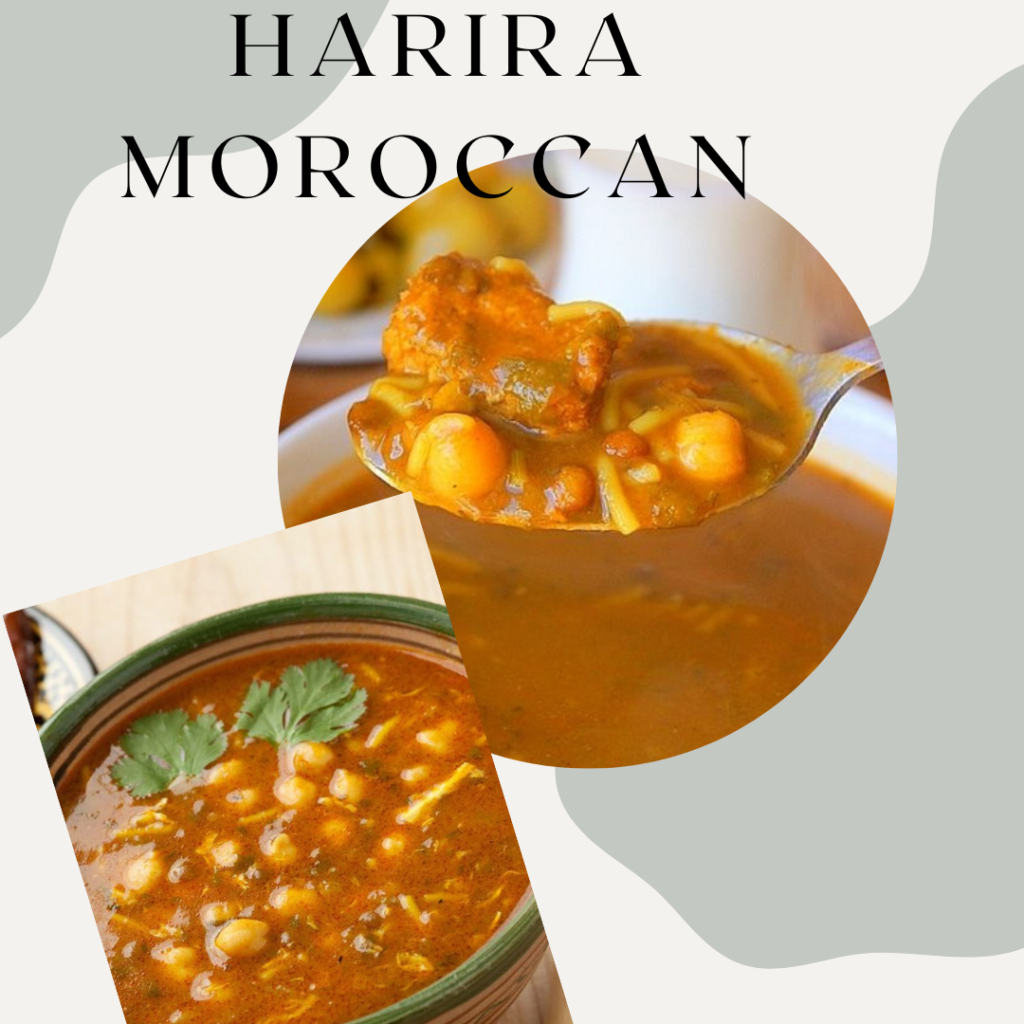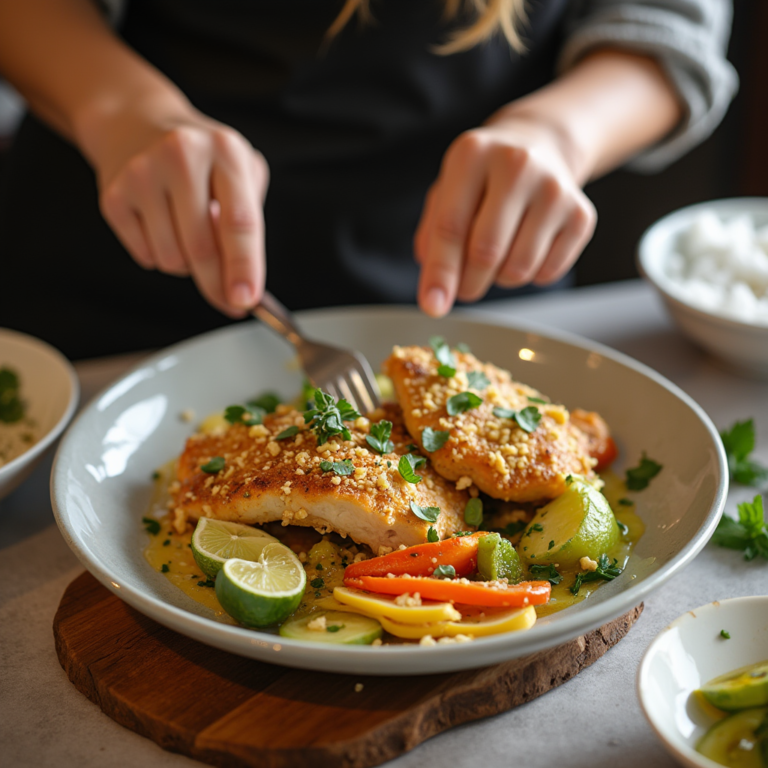Easy Harira soup with basic ingredients
Introduction to Harira Soup
What is Harira?
Easy Harira soup with basic ingredients is a traditional Moroccan soup, cherished for its rich, comforting flavors and hearty ingredients. This tomato-based soup is typically made with lentils, chickpeas, and a blend of aromatic spices, creating a dish that is both flavorful and nutritious. While it’s enjoyed year-round, Harira holds special cultural significance during the month of Ramadan, where it is often served to break the fast at Iftar.
Many families across Morocco have their own variations of this soup, with some recipes passed down through generations. Whether you’re looking for an easy homemade Harira soup recipe or a more authentic Moroccan Harira soup recipe, this dish is deeply ingrained in Moroccan cuisine and culture.

History and Cultural Significance of Harira in Morocco
Harira has a long and rich history in Morocco. Its origins are rooted in the Berber tradition, with influences from Arab and Andalusian cuisine over centuries. For many Moroccan families, Harira soup with lentils and chickpeas is a symbol of togetherness, warmth, and hospitality. The soup is often served during large family gatherings or special occasions.
One of the most significant cultural aspects of Harira is its association with Ramadan. During this holy month, Harira is often the first dish served to break the day’s fast at sunset. Its hearty ingredients provide much-needed energy and nutrients after a day of fasting. Many variations of Harira soup for Ramadan can be found, but the core elements—chickpeas, lentils, tomatoes, and a fragrant spice blend—remain the same.
Easy Harira Soup with Basic Ingredients
For those new to cooking Moroccan dishes or looking for a simpler version, an easy Harira soup with basic ingredients is a great place to start. While traditional recipes can call for a long list of spices and ingredients, you can create a delicious Harira using common items like lentils, tomatoes, and chickpeas, along with a few essential spices like cumin, ginger, and coriander.
How to Make Moroccan Harira Soup
When learning how to make Moroccan Harira soup, the process is surprisingly straightforward. Whether you’re aiming for a quick weeknight meal or preparing for a special occasion like Ramadan, Harira’s versatility makes it accessible for any cook. By following a few key steps and adjusting the recipe to your taste, you can create a soup that’s both comforting and flavorful.
Traditional Harira Soup with Lentils and Chickpeas
A traditional Harira soup with lentils and chickpeas is the foundation of many family recipes. These legumes are simmered slowly to soak up the rich flavors of the broth, creating a wholesome dish that’s both filling and nutritious. Some versions also include lamb or beef, but the vegetarian version is equally satisfying.

Best Harira Soup for Ramadan
When it comes to finding the best Harira soup for Ramadan, many look for recipes that are rich in nutrients but not too heavy, making it the perfect dish to break a fast. This version typically includes a generous amount of chickpeas and lentils, as well as a balance of warming spices like cinnamon and ginger, which aid digestion and add depth to the soup’s flavor.
No matter which version you try, Harira remains a beloved dish that reflects the warmth and hospitality of Moroccan culture. Whether you’re making an easy homemade Harira soup or an authentic Moroccan Harira soup recipe, this soup is sure to bring comfort to your table.
Ingredients for Harira Soup:

Key Ingredients for Harira
The beauty of Harira soup lies in its use of simple yet wholesome ingredients that come together to create a deeply flavorful and satisfying dish. Whether you’re preparing an easy Harira soup with basic ingredients or an authentic Moroccan Harira soup recipe, the following ingredients form the foundation of this beloved Moroccan soup:
- Tomatoes: Harira’s rich base starts with tomatoes, either fresh or canned, which give the soup its vibrant color and slightly tangy flavor.
- Chickpeas: A key component of Harira, chickpeas add texture, protein, and heartiness to the soup.
- Lentils: Both brown or green lentils are commonly used. They help thicken the soup and provide an earthy flavor.
- Onions: Finely chopped onions form the aromatic base of the soup, adding depth and sweetness.
- Celery: Chopped celery enhances the soup’s flavor and adds a subtle crunch.
- Fresh Herbs: Fresh parsley and cilantro (coriander leaves) are often added towards the end of cooking, adding brightness to the rich soup.
- Meat (Optional): While many traditional Harira soups with lentils and chickpeas are vegetarian, lamb or beef is sometimes included to add richness.
- Flour or Vermicelli: Some variations thicken the soup with a small amount of flour, while others use vermicelli noodles for a slightly different texture.
Traditional Spices and Flavors
Harira’s iconic flavor comes from the combination of aromatic spices, which are typical of Moroccan cuisine. Here are the key spices that make Harira so distinctive:
- Cumin: Cumin adds a warm, earthy flavor to the soup and is a staple in Moroccan cooking.
- Ginger: Fresh or ground ginger provides a slight heat and complexity to the soup.
- Turmeric: This spice not only gives Harira a beautiful golden hue but also adds a subtle bitterness and warmth.
- Cinnamon: Often used in Moroccan dishes, cinnamon adds a sweet warmth that balances the soup’s savory and spicy elements.
- Paprika: This adds a mild smoky flavor and enhances the soup’s overall depth.
- Black Pepper: To give the soup a bit of a kick, black pepper is commonly added.
- Saffron (Optional): For those aiming for a more authentic Moroccan Harira soup recipe, saffron can be added. It’s a luxurious spice that provides both color and flavor.
In addition to these spices, salt and olive oil are used to season and enhance the overall flavor. These traditional spices, combined with fresh herbs and vegetables, create a robust and aromatic soup that’s perfect for any occasion, especially during Ramadan when many seek the best Harira soup for Ramadan to enjoy at Iftar.
No matter how simple or elaborate your recipe is, these ingredients and spices are the key to mastering how to make Moroccan Harira soup. The combination of legumes, fresh herbs, and warming spices results in a rich, nourishing dish that’s perfect for family gatherings or quiet nights at home.

Step-by-Step Recipe for Moroccan Harira Soup:
Preparing the Ingredients
- Chickpeas:
- If using dried chickpeas, soak them overnight, then drain and rinse them before cooking. Canned chickpeas can be used for convenience—just drain and rinse them well.
- Lentils:
- Rinse the lentils under cold water and set them aside. There’s no need to soak lentils beforehand, as they cook relatively quickly.
- Vegetables:
- Tomatoes: If using fresh tomatoes, blanch them in boiling water for 30 seconds, then peel and finely chop or blend them into a puree. You can also use canned tomatoes for convenience.
- Onions and Celery: Finely chop one medium onion and two celery stalks.
- Herbs:
- Chop a handful of fresh parsley and cilantro, keeping some extra cilantro aside for garnish.
- Spices:
- Measure out the following spices: 1 tsp of cumin, 1 tsp of paprika, ½ tsp of ground ginger, ½ tsp of turmeric, ½ tsp of ground cinnamon, and a pinch of black pepper.
- Thickener (optional):
- If you prefer a thicker soup, whisk 1-2 tbsp of flour with water to create a slurry, or prepare a handful of vermicelli noodles to add during cooking.
Cooking Instructions
- Heat Oil:
- In a large pot, heat 2-3 tbsp of olive oil over medium heat.
- Sauté the Vegetables:
- Add the chopped onions and celery to the pot, cooking until soft and fragrant (about 5-7 minutes).
- Stir in the garlic (if using) and cook for another minute.
- Add Spices:
- Stir in cumin, ginger, turmeric, paprika, cinnamon, and black pepper. Cook for 1-2 minutes, allowing the spices to release their aromas.
- Add Tomatoes:
- Stir in the chopped tomatoes or tomato puree, and cook until the mixture starts to thicken (about 5-7 minutes).
- Add Lentils and Chickpeas:
- Add the lentils and pre-soaked or canned chickpeas to the pot, stirring well to coat them in the spices and tomato base.
- Add Water or Broth:
- Pour in 6-8 cups of water or vegetable broth. If using meat, this is the point to add cubed lamb or beef.
- Bring the soup to a boil, then reduce the heat to low and let it simmer uncovered for about 45 minutes to 1 hour. Stir occasionally, checking that the lentils and chickpeas are cooked through.
- Thicken the Soup (Optional):
- If you prefer a thicker consistency, add the flour slurry or vermicelli noodles during the last 10 minutes of cooking.
- Finish with Herbs:
- Stir in the chopped parsley and cilantro during the last few minutes of cooking. Taste and adjust the seasoning with salt, pepper, or more spices as needed.
- Serve:
- Serve the Harira hot, garnished with fresh cilantro and a wedge of lemon on the side. It’s often enjoyed with dates or traditional Moroccan sweets like chebakia during Ramadan.
Tips for Achieving Authentic Flavor:
- Slow Simmer:
- Allowing the soup to simmer slowly helps the flavors develop. The longer it simmers, the more the spices infuse the lentils, chickpeas, and broth, giving you that rich, deep flavor Harira is known for.
- Use Fresh Herbs:
- Fresh parsley and cilantro are key to achieving authentic Moroccan flavor. Add them at the end of cooking to keep their brightness intact.
- Spices:
- Harira is all about the balance of spices. Taste and adjust as you go. You can always add a pinch more cumin or a dash of cinnamon to deepen the flavor.
- Tomatoes:
- The tomato base is essential for both color and taste. If fresh tomatoes are out of season, high-quality canned tomatoes or tomato paste can deliver a consistent, rich flavor.
- Saffron (Optional):
- For an extra touch of authenticity, you can add a few strands of saffron towards the end of cooking for a subtle yet luxurious flavor.
- Resting Time:
- Harira often tastes better the next day, as the flavors have more time to meld together. Prepare it ahead of time for even more depth of flavor.
By following these steps and tips, you’ll create a delicious and comforting authentic Moroccan Harira soup recipe that reflects the richness and warmth of Moroccan cuisine!
Variations of Harira Soup:
Regional Variations of Harira
While Harira is a staple across Morocco, different regions have developed their own variations of the dish, influenced by local ingredients and traditions. Here are a few of the most notable regional differences:
- Harira from Fez:
- Rich and Hearty: The city of Fez is known for its elaborate and flavorful Harira. This version often includes lamb or beef, which adds richness to the soup. It’s also thickened with a flour-based slurry or sometimes with egg, making it heartier.
- Spices: In Fez, the spice profile can be more complex, sometimes incorporating saffron and more generous amounts of cinnamon for a slightly sweet undertone.
- Harira from Marrakech:
- Lighter and Simpler: The Marrakech version of Harira tends to be a bit lighter compared to Fez. It often uses fewer spices and may include less meat, making it closer to an easy Harira soup with basic ingredients.
- Vermicelli Noodles: Some versions in this region may include vermicelli noodles instead of flour as the thickening agent, giving the soup a slightly different texture.
- Berber Harira:
- Rustic and Minimalistic: The Berber version of Harira is simpler and more rustic. It usually focuses on plant-based ingredients like lentils and chickpeas, with minimal use of meat or flour. This version is similar to a vegetarian Moroccan Harira soup, focusing on legumes and earthy flavors.
- Locally Sourced Ingredients: Depending on the season, Berber Harira may include additional vegetables such as squash or potatoes.
- Harira for Ramadan:
- Special Additions: Across all regions, Harira made during Ramadan is often more elaborate. Many families add extra ingredients like chebakia (sesame cookies) on the side to complement the soup. The version made for Ramadan tends to be more nutrient-dense, often including more meat and chickpeas to provide energy for those breaking their fast.
Vegetarian and Vegan Versions
Many variations of Harira are naturally vegetarian, focusing on the soup’s core ingredients—lentils, chickpeas, tomatoes, and herbs. By omitting meat and dairy, a vegan Harira can still be incredibly flavorful and satisfying.
- Basic Vegetarian Harira:
- This version keeps the base recipe but excludes any meat, focusing solely on the plant-based ingredients. Chickpeas and lentils provide plenty of protein and fiber, making this version hearty and nutritious without needing animal products.
- Spices: To add richness in the absence of meat, it’s important to enhance the flavor with additional spices like cumin, turmeric, and paprika. A dash of smoked paprika can bring a deeper flavor as well.
- Vegan Harira with Vegetables:
- Many vegan versions of Harira incorporate seasonal vegetables like carrots, zucchini, or spinach. These vegetables add color, texture, and extra nutrients, making the soup even more filling.
- Tomato Base: The rich tomato base remains the focal point of the soup, along with the classic combination of chickpeas and lentils. A small amount of tomato paste can be added to boost the soup’s depth of flavor.
- Gluten-Free Vegan Harira:
- For those avoiding gluten, the flour traditionally used to thicken the soup can be replaced with a cornstarch slurry or omitted entirely for a thinner broth. Alternatively, some gluten-free versions may use quinoa as a thickener, adding extra protein.
- Vermicelli Noodles: Gluten-free vermicelli or rice noodles can be used to replace traditional wheat-based vermicelli, providing the same texture in the soup.
- Spice-Enhanced Vegan Harira:
- Without the addition of meat, vegan versions often rely more on the spices to build layers of flavor. Along with cumin, ginger, turmeric, and cinnamon, some cooks may add extra heat with chili flakes or harissa for a spicier kick.
Experimenting with Proteins and Legumes:
- Lentil-Only Harira: In some vegetarian or vegan households, Harira is made with lentils as the sole legume, omitting chickpeas for a smoother texture. This version cooks faster and has a lighter consistency.
- Adding Plant-Based Proteins: For an extra protein boost, some cooks experiment with adding tofu or tempeh, though this is less traditional. Another popular variation includes adding cooked quinoa or millet, which is also gluten-free.
By exploring these regional variations of Harira and trying out vegetarian and vegan versions, you can enjoy the versatility of this Moroccan classic while catering to different dietary preferences. Whether you stick to the traditional authentic Moroccan Harira soup recipe or experiment with new ingredients, the soup remains a comforting and satisfying meal.
Serving Suggestions for Harira Soup:
Traditional Accompaniments
Harira is often served with a variety of side dishes and accompaniments that enhance the overall dining experience. Here are the most common traditional pairings:
- Dates:
- Dates are an integral part of the Harira experience, especially during Ramadan. When breaking the fast, Muslims traditionally eat dates first, followed by a bowl of warm Harira. The sweetness of the dates contrasts beautifully with the savory and spiced soup, providing a burst of natural energy and nutrients.
- Chebakia:
- Chebakia is a popular Moroccan pastry made of dough that’s shaped into a flower, fried until golden, and coated in honey and sesame seeds. This sweet and crunchy treat is often served with Harira during Ramadan, offering a delightful balance between the sweetness of the pastry and the warmth of the soup.
- Moroccan Bread (Khobz):
- Moroccan flatbread, also known as Khobz, is commonly served with Harira. The soft, slightly chewy bread is perfect for soaking up the rich broth and scooping up lentils and chickpeas. Some regions also serve Msemen, a layered Moroccan flatbread, alongside the soup.
- Lemon Wedges:
- Serving lemon wedges on the side allows diners to squeeze fresh lemon juice into the soup. This adds brightness and a tangy flavor that complements the warm spices in Harira. It’s a personal preference, but many people find the acidity from the lemon enhances the overall flavor.
- Olives:
- Small bowls of Moroccan olives are often served alongside Harira. The salty, briny flavor of the olives contrasts nicely with the richness of the soup.
- Fresh Cilantro and Parsley:
- Fresh herbs like cilantro and parsley are not only used in cooking Harira but are also served as a garnish. A sprinkle of these herbs adds a burst of fresh flavor, brightening up the hearty soup.
Frequently Asked Questions about Harira
Can Harira Be Frozen?
Yes, Harira can be frozen and stores very well for later use. To freeze Harira:
- Cool the Soup: Allow the soup to cool completely before transferring it into freezer-safe containers or heavy-duty freezer bags.
- Portion Control: For convenience, portion out the soup into single servings before freezing. This makes it easier to thaw only the amount you need.
- Storage: Harira can be frozen for up to 3 months. Label the containers with the date to keep track of freshness.
- Reheating: When reheating frozen Harira, thaw it overnight in the refrigerator, or reheat it directly on the stove over low heat, adding a little water or broth to restore its original consistency.
How Long Does Harira Keep?
Harira keeps well in the refrigerator for 3 to 5 days. Store it in an airtight container to preserve its freshness. Like many soups and stews, Harira often tastes even better the next day, as the flavors have more time to meld together.
- Reheating Tip: Reheat gently on the stovetop over medium heat, stirring occasionally. You may need to add a splash of water or broth to thin the soup, as it can thicken after refrigeration.
Substitutions for Certain Ingredients
If you’re missing a particular ingredient, here are some common substitutions for making a flavorful Harira:
- Meat:
- If you don’t have lamb or beef, you can substitute with chicken or omit meat altogether for a vegetarian version.
- Chickpeas:
- If you’re out of chickpeas, you can substitute them with white beans or cannellini beans, which have a similar texture.
- Lentils:
- Harira traditionally uses brown or green lentils, but you can substitute with red lentils, though they will cook faster and break down more, giving the soup a creamier texture.
- Spices:
- If you don’t have all the traditional spices (cumin, turmeric, cinnamon, etc.), focus on cumin and paprika, as they are the essential flavors. You can also add curry powder for a different twist.
- Flour:
- For gluten-free options, instead of thickening the soup with flour, you can use cornstarch or simply add more lentils, which naturally thicken the broth. Another option is to use gluten-free vermicelli.
- Tomatoes:
- If fresh tomatoes aren’t available, use canned crushed tomatoes or tomato paste to build the base of the soup.

Conclusion
Why You Should Try Making Harira at Home
Harira is much more than just a soup—it’s a comforting, wholesome dish with deep cultural roots in Morocco. Whether you’re looking to explore new culinary traditions, preparing a special meal for Ramadan, or simply seeking a hearty, flavorful dish for your family, Harira offers something for everyone.
Here’s why you should try making Harira at home:
- Rich Flavor: The combination of warming spices, fresh herbs, and hearty ingredients like lentils and chickpeas creates a complex yet balanced flavor profile that is both comforting and satisfying.
- Simple and Adaptable: Harira can be made with basic ingredients that you likely already have in your pantry. It’s also highly adaptable, whether you’re following a traditional recipe or making a vegetarian or vegan version.
- Nutritious and Filling: Packed with protein, fiber, and vitamins, Harira is a complete meal that provides nourishment and energy. It’s especially beneficial during Ramadan, as it replenishes the body after fasting.
- Perfect for Meal Prep: Harira is one of those dishes that tastes better the next day, making it an ideal candidate for meal prep. You can make a big batch, enjoy it over several days, or freeze portions for easy meals later.
- Cultural Exploration: Making Harira allows you to experience a piece of Moroccan culture from your kitchen. Whether you’re recreating a dish you’ve had on your travels or trying it for the first time, Harira offers a taste of Morocco’s rich culinary heritage.
Give Harira a try at home, and you’ll discover why this beloved soup has been cherished for generations!







